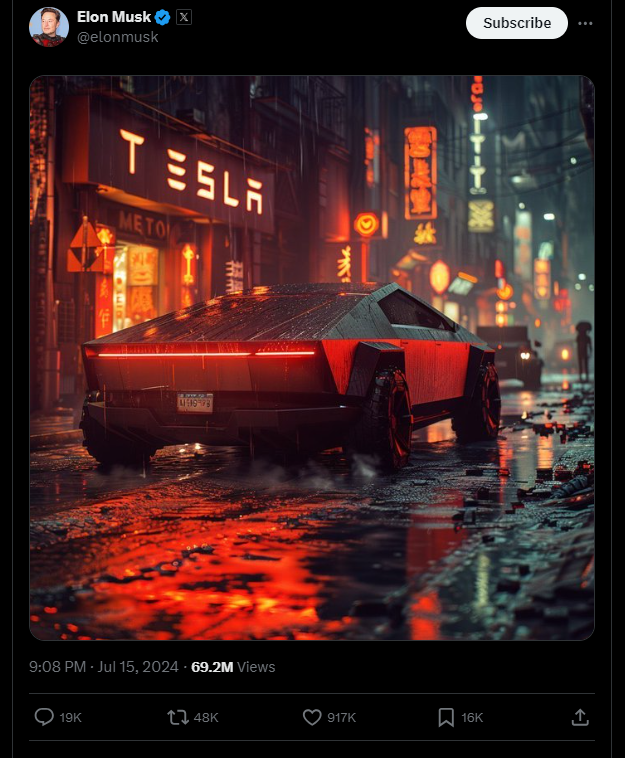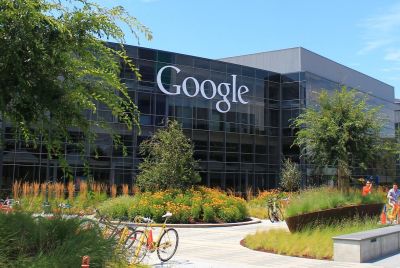Elon Musk Sparks New Tesla Cybertruck Variant Rumours With AI Image; Explains Robotaxi Event Delay
Musk delays robotaxi unveiling for Tesla design changes

Tesla CEO Elon Musk shared an AI-generated image of the Cybertruck on his social media platform. The image, uploaded without comment to his X account, has sparked speculations among Tesla enthusiasts about a potential new Cybertruck variant or edition.
Musk's history suggests a penchant for unconventional product announcements. In January, for instance, the billionaire provided veiled hints about a few "other products" under development at the company's headquarters. So, the AI-generated image could be significant.
Musk Shares Cryptic Tesla Cybertruck Image
It could be a deliberate hint at a future Cybertruck variant or simply an image shared without specific meaning. The AI-generated image portrays a futuristic Tokyo cityscape bathed in the glow of night lights, with light rain falling – an aesthetic reminiscent of the "Blade Runner" film.

This variant of the Cybertruck has a lower ride height, resembling a sedan more than the standard Cybertruck. It retains the signature grey colour and the red taillights of the original design.
While Musk remains silent on the image's meaning, he nevertheless confirmed a delay in the August 8 robotaxi unveiling due to a design change. Regrettably, he did not provide a new date for the event.
However, in a Monday post on his social media platform, X (formerly known as Twitter), Musk revealed that he requested a design change to the vehicle's front. A Bloomberg News report on Thursday attributed Musk-requested design changes to the robotaxi event's postponement to October.
This news initially caused an 8 percent drop in Tesla's share price that day. However, the stock has since rebounded and was up nearly 3 percent during Monday's afternoon trading session. Tesla shares were down more than 40 percent earlier in the year but have risen over 80 percent since hitting a 52-week low in April.
Delayed Robotaxi Unveiling And Design Modifications
Musk has long envisioned Tesla's "Full Self-Driving" system enabling a network of robotaxis to generate revenue for both the company and Tesla owners. This system would use electric vehicles when they're not being used by owners, maximising their potential.
Since the "Full Self-Driving" hardware became available in late 2015, Musk has been a vocal proponent of self-driving vehicles as a key driver of Tesla's growth. Thousands of Tesla owners are currently participating in real-world testing of the system.
The US National Highway Traffic Safety Administration (NHTSA) reported finding 75 crashes and one fatality involving "Full Self-Driving" in their investigation documents. It remains undetermined whether the system itself contributed to these incidents.
Musk envisions Tesla's driverless taxi service operating like a hybrid of Airbnb and Uber. Tesla owners can contribute their vehicles to the fleet when not in use, functioning like "a combination of Airbnb and Uber."
Tesla released a demo clip a few weeks ago that offered a glimpse into the potential user experience for its driverless taxi service. The clip featured Rosalie Nathans, a Tesla senior manager for used cars and online sales, using the app to request and enter a driverless vehicle.
"Still pinching myself that I got to demo Tesla's ride-hailing platform," Nathans wrote in a LinkedIn post. In the video, Nathans initiates the service by tapping a black-and-white "summon" button on the app. Within seconds, the app displays a map indicating a car three minutes away from her pickup location.
The car's details, including seating capacity and current temperature, are also shown. The video then depicts Nathans adjusting the car's temperature remotely before its arrival.
Upon entering the vehicle, the video showcases the central display. It features a route map prominently positioned at the top, likely displaying the estimated arrival time, remaining minutes to the destination, and distance in miles.
Additionally, the screen offers passengers control over their ride experience by allowing adjustments to the car temperature, audio volume, and music selection. At first glance, it looks a lot like Uber or Lyft—except there's no human driver visible in the video.
© Copyright IBTimes 2025. All rights reserved.





















